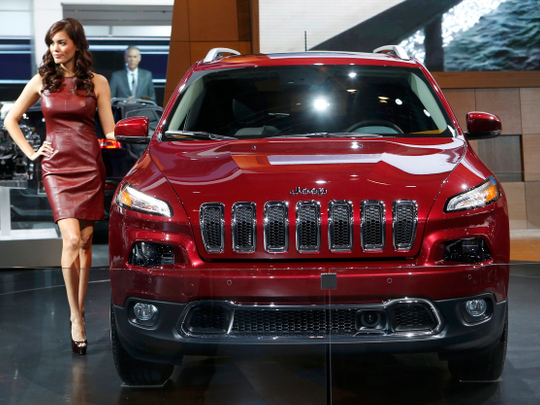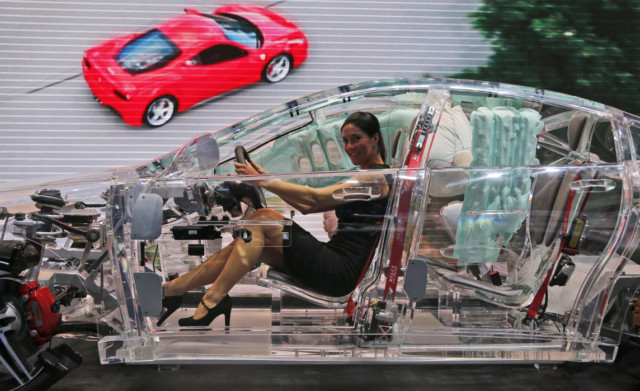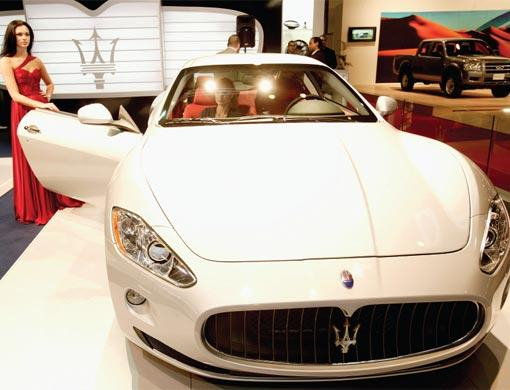
Detroit: Women are the auto world’s fastest-growing audience. But walk among the marketing for luxury coupes and high-octane supercars at the Detroit auto show, and you’ll find that women, instead of driving, are mostly confined to model heels or passenger seats.
Even as women rise to power at the country’s biggest automakers and help set new sales records for cars and trucks, the auto world still struggles to represent anyone other than just car guys.
“It’s somewhat transformational. [The industry is] seeing women aren’t just getting in the side doors of these trucks. They’re buying them, driving them, using them,” said Marc Bland, a vice-president for IHS Automotive, an industry research group. “The manufacturers have recognised it’s time to change some of the stereotypical approaches ... But change, as always, takes time.”
Women bought nearly 40 per cent of the more than 16 million cars and trucks sold nationwide last year, up from about 36 per cent five years ago, J.D. Power data show. Citing a study that said women spend $300 billion a year on vehicles and maintenance, the Alliance of Automobile Manufacturers, a group of top automakers, called women “the engine of the auto economy”.
But men’s influence on autos is still strong. Nine out of 10 car salespeople at dealerships are men, according to the National Automobile Dealers Association, and women account for less than a third of the attendees at auto shows, according to the Alliance of Automobile Manufacturers.
Female focus groups routinely tell surveyors they feel misunderstood by the grit and machismo of modern car marketing. “The automotive industry is an old boys’ club in many respects,” Melody Lee, a director of brand and reputation strategy for Cadillac, told Ad Age.
In an industry where only 3 per cent of the executive positions are filled with women, they have also taken on higher profiles at the automakers’ top ranks, led by Mary Barra, the first female chief executive of a major car company, taking over America’s largest automaker, General Motors, last year.
Women also power one of the biggest truck brands (Ram, which Becky Blanchard took over as director of this month), oversee the best-selling truck line in North America (the Ford F-150, run by lead engineer Jackie DiMarco, who started at Ford as a designer of 3.8-litre engines) and are credited with some of the truck world’s top designs (the Chevrolet Colorado, led by vehicle chief engineer Anita Burke, was named Motor Trend magazine’s 2015 ‘truck of the year’).
One of the stars of the Detroit show, Acura’s stylish NSX supercar, was designed by Michelle Christensen, the company’s first female exterior designer.
After a strong year for auto sales, this year’s show has focused largely on performance, sports and supercars, breaking away from years of recession-era focuses on smaller sedans and green vehicles. But to keep the momentum going, analysts said automakers will need to pay attention to vehicles that sell better with women, including the compact crossover SUV, which now commands 12 per cent of the country’s auto sales, about the size of the market share for full-size pickups.
Unlike trucks, crossovers’ sales volume has grown nearly 80 per cent since 2007, according to data compiled by Alec Gutierrez, a senior analyst at Kelley Blue Book. And IHS Automotive records show most registrations for top SUV and crossover models, like the Toyota Rav4 and Nissan Rogue, are in the names of female drivers. (The most male-dominated cars: the Ferrari F12 Berlinetta and McLaren MP4, both luxury supercars, with 94 per cent of registrations in men’s names.)
That has led some of the auto world’s top players to expand their focus. Tesla’s chief executive, Elon Musk, said in June that the all-electric carmaker would be “paying more attention to the needs of women” for its SUV-minivan mix Model X, and called the Model S, a luxury sedan, “too guy-centric”.
Tesla designers also convened a panel of women at the company’s Palo Alto, California, headquarters last year to survey which aspects of the Model X women found most appealing; more than half of its orders so far have come from women, Musk has said.
Automakers crossed into other makes to appeal to broader audiences: Jaguar, known for its luxury cars, unveiled a “performance crossover” called the F-PACE; Bentley said it would consider a smaller version of its newly unveiled SUV, the Bentayga, to win over women and younger buyers. The audience is often seen as urban women with buying power and an occasional need to move or haul.
A Nissan executive said last summer that women make the final decision in more than 60 per cent of new car purchases. And reaching young women is even more crucial for automakers looking to lock in lifetime drivers: 64 per cent of women between ages 22 and 30 said they had bought a car or truck, compared to 44 per cent of millennial men, a 2011 nationwide survey by communications firm Capstrat found.
Hyundai, in announcing its Santa Cruz, an unusual crossover-pickup truck mix, said millennials, and women specifically, were helping lead the push for changes to their newest debuts. “We call the people leading this shift ‘urban adventurers,’” said Mark Dipko, a director for Hyundai Motor America. ”They have a different mindset.”
Expanding beyond a traditional male audience has led to subtler touches, like lower steps for trucks and SUVs and, as Lincoln’s design director said, a trunk door redesigned to be easier for both men and women to use.
After the designs have finished, automakers have tried different ways to keep their female audience involved. Buick partnered with the Food Network to display cars at food and wine festivals. Ford launched a sweepstakes with clothing-rental company Rent the Runway.
Still, marketing specifically to women carries the danger of talking down to a highly varied national audience. Miss the mark, analysts said, and your brand risks characterising all of America’s more than 100 million female drivers as minivan soccer moms, or worse.
The struggle automakers have with winning over women mirrors their marketing battle for young drivers, who analysts said can tell when they’re being talked to, and flinch as a result.
“They don’t want to be marketed to, because they can sniff it out,” said AutoTrader spokesperson Nicole Yelland. “It feels false, and they want something authentic.”
A triumph can prove well worth it. Instead of having its commercials show pro drivers revving sports cars or conquering mountains, Subaru has based ads on heart-warmers and slice-of-life stories as part of its “Love” campaign: In one, for instance, a father imagines his daughter as a baby girl in the driver’s seat.
They are stories that touch both genders, analysts said, and they have worked. In the five years after the ads began, in 2008, US sales doubled. Subaru has seen six straight years of record-setting sales, and last year raised its US market share to nearly 4 per cent, an all-time high.
Even America’s truck empire, long represented in ads with cowboy machismo or workman grit, has pushed to expand beyond men, who bought 85 per cent of the trucks sold nationwide in the first nine months of 2014, IHS Automotive data show.
In November, Dodge Ram announced that country star Miranda Lambert, whom it called a “truck woman through and through”, would be the brand’s new spokesperson, auctioning off a Ram 1500 Laramie Longhorn customised with bright flourishes in the leather seats.
In women, the truck world sees a growth audience beyond the traditional clientele: buyers who skip the traditional minivan or SUV for a four-door crew-cab truck with roomy back seats. Most Rams sold last year were crew-cab trucks, with cushy interiors and amenities that would fit better on a suburban road than a construction site.
But the last thing many women want, analysts said, is to be underestimated on the car lot — on in the national ads.
“Women-only marketing has never worked. We’ve seen ones with pink cars, umbrellas, little purse holders,” AutoTrader senior analyst Michelle Krebs said. “I’ve never liked being singled out. Just give me really good advertising, really good cars.”
— Washington Post














